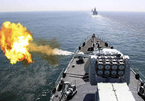Historical evidence proves the country’s sovereignty over the two archipelagos, especially through ancient bibliographies.
The Vietnamese people have left their footprints on the Hoang Sa (Paracel) and Truong Sa (Spratly) islands since ancient times. Historical evidence proves the country’s sovereignty over the two archipelagos, especially through ancient bibliographies.
Understanding the importance of seas and islands, Vietnam’s feudal dynasties built powerful navies to tackle foreign invasions. It is a sacred duty, drawing on the heroic traditions of the Vietnamese people and the country’s history.
According to “Dai Viet su ki toan thu” (the Complete Chronicles of Dai Viet), in the 11th month of the year of Đại Định (1161), under the reign of King Ly Anh Tong, the emperor ordered To Hien Thanh to take 20,000 soldiers on patrol in the southwest coastal area. In the spring of 1172, the king patrolled the islands, expressing the idea of including them on the map of Vietnam.
When the emperor’s reign brought prosperous times to the country, he ordered courtiers to officially draw a “Thiên Hạ bản đồ” (a map of Vietnam’s air and land territories), confirming its sovereignty and independence.
The introduction of the “Quoc su quan trieu” (an official Nguyễn-era compilation of Vietnamese history, geography, and people from the 1820s to 1945) in 1820, at the beginning of the reign of Emperor Minh Mang, left a range of valuable scientific research for following generations.
Bibliographies and “Chau Ban” documents (official royal administrative papers) represent enormous sources of knowledge that not only record history, geography, and medicine, but also sea and island exploration and management matters. In particular, it includes the opinion of Vietnam’s feudal state towards the two archipelagos, which affirmed territorial sovereignty in building and safeguarding the country. Through the ups and downs of history, every feudal dynasty experienced prosperity and decline, but the country’s sovereignty, including over Hoang Sa and Truong Sa, has never changed.
Associate Professor, Dr Trinh Khac Manh - Director
Han-Nom Research Institute
Ancient bibliographies such as “Han Nom”, “Chau Ban” documents, and records on Vietnam’s sovereignty over the seas and islands of Truong Sa and Hoang Sa as well as the East Sea are particularly valuable. Vietnam’s sovereignty over Truong Sa and Hoang Sa is seen on maps drawn in the 17th century.
Ha Minh Hong - Former Dean of the History Department
University of Social Sciences and Humanities - VNU HCM City
Ancient historical documents from Vietnam and China and other countries such as Spain, Portugal, Germany, and the Netherlands reflect the common perception of the world from past to present. The evidence of Vietnam’s national sovereignty from the mainland to seas and islands are clearly stated in the documents, including the Truong Sa and Hoang Sa archipelagos.
“Thien nam tu chi lo do thu” (The Handbook of the South’s Road Map) is an atlas showing directions in the south. It also forms part of the “Hong Duc” map, which was drawn under the Le Thanh Tong Dynasty. This is considered the first bibliography describing the presence of Vietnam’s Paracel and Spratly archipelagos./. VNA

China changes sovereignty claim in the East Sea: hope or illusion?
“This is the time for China to give up the 9-dash line. This does not affect their interests,” said Dr. Li Nan, a research fellow at the East Asian Institute, National University of Singapore, at a recent online seminar on the East Sea.